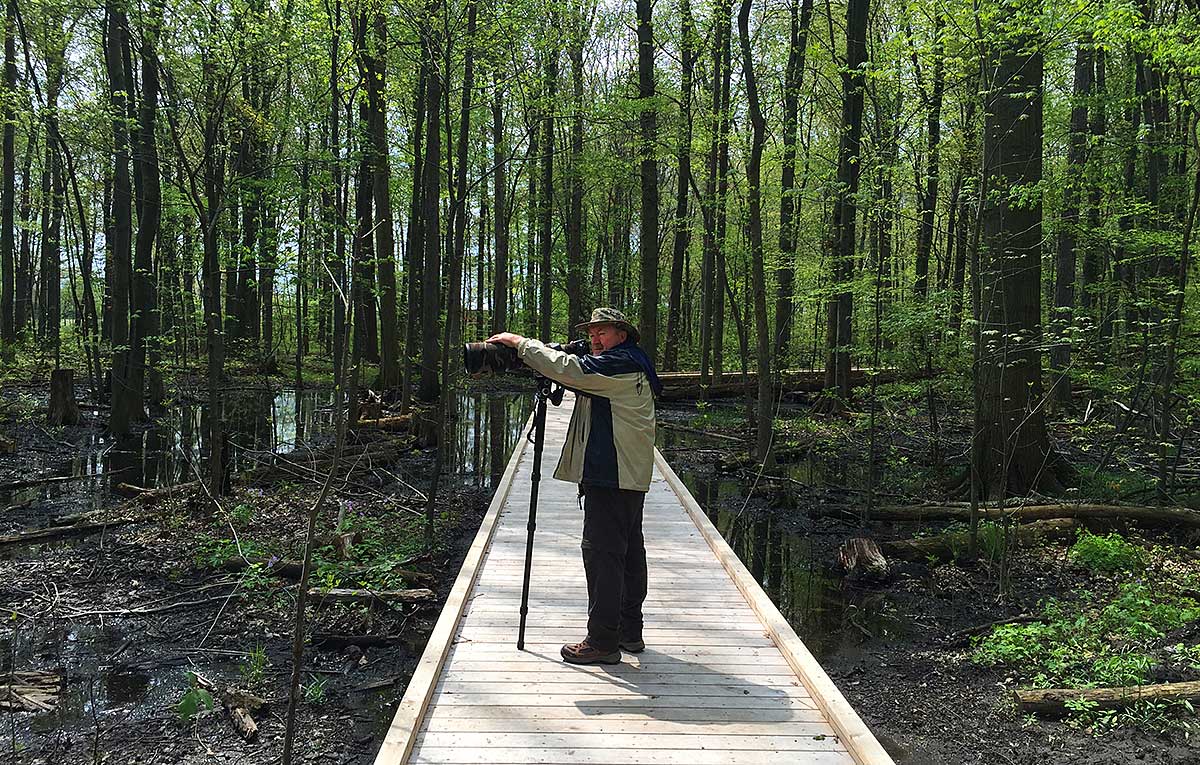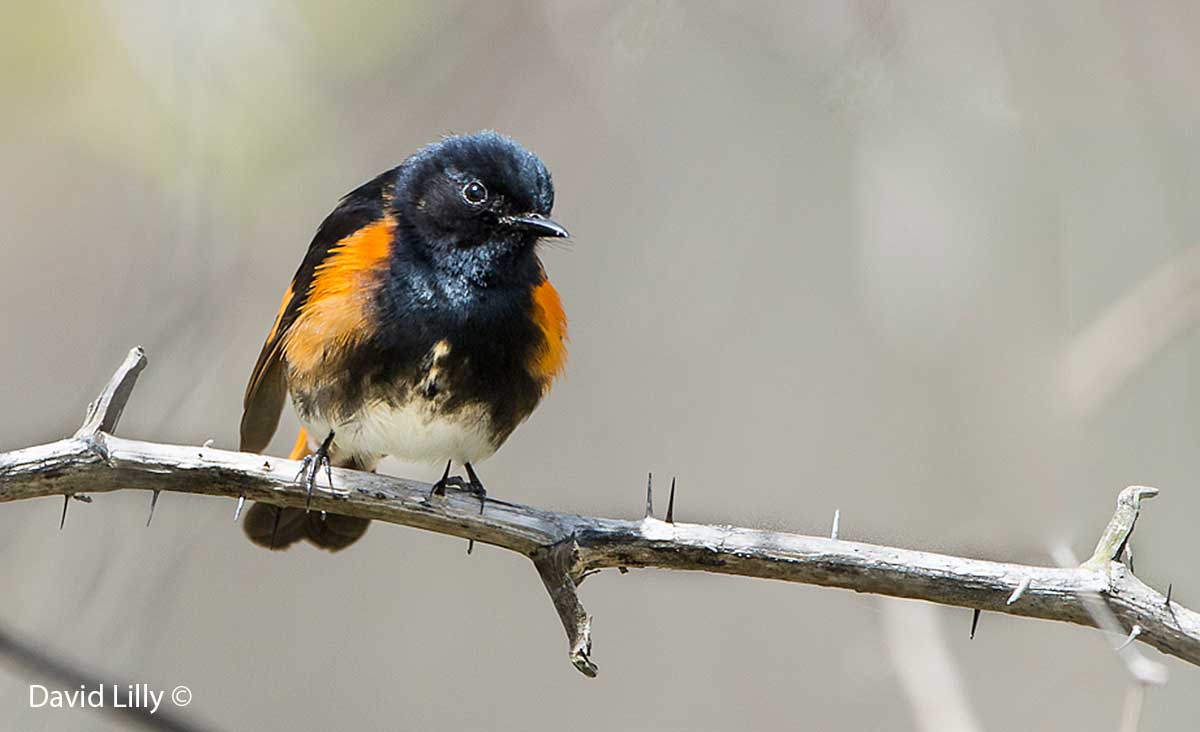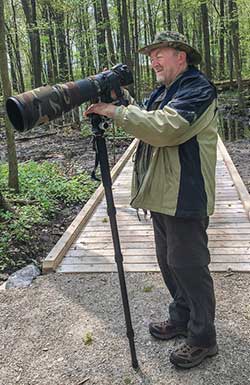
Photographing Warblers at Point Pelee
by David Lilly
May 22, 2016

Birders on the trail at Point Pelee
Warblers have always fascinated me. They are beautiful, they are colourful, they are resilient, and they are very difficult to photograph. It takes years to get really good images. From the 11th of May to the 19th of May 2016 myself and fellow photographer Daryl Hansen decided to go to the best location in Canada, Point Pelee National park in Ontario to photograph these amazing little creatures and any other birds that presented themselves.

Summer Tanager
Designated as a park in 1918, Point Pelee is world-renowned for migratory songbirds. It is also designated as an 'Important Birding Area” and a UNESCO “Wetland of International Significance” The locals call it the Warbler Capital of Canada. Point Pelee Map.

Common Yellowthroat
Point Pelee has been on my wish list for a long time now. I have heard many stories about the number of warblers and other birds at this park. These small birds travel thousands of kilometres twice a year, migrating through and nesting in this area. In the spring they are in their breeding plumage and they sing which makes them easier to find. Also, the trees leaf out later due to the cooling effect of Lake Erie making it easier to see and photograph the small birds.

Forest at Point Pelee
We arrived, in Leamington, a small town just 10 minutes from the entry point to Point Pelee on May 11. With a long-day's travel behind we decided to get up early the next morning, arriving at the park information centre at 5:45 AM. Rather than walking the two kilometers the plan was to catch the small bus to the tip to see any birds that may have flown in overnight. We did this for two days, but unfortunately did not see to much. So, for the remainder of the days we went to the Information Center in the morning to see the bird reports from the day prior. Usually, there were other bird photographers that had information on good birding locations on the trails leading off from the center. We continued this routine for the remainder of our time in the park. Also, for two of the evening walks we went to the amazing Marsh Board Walk. On all trails there were many warblers and other birds.

Panoramic Photo of the marsh taken with an iphone

Boardwalk from the marsh and bird look out.

Dave Lilly with 500 mm lens on board walk in Point Pelee (photo taken by Daryl Hansen)

Point Pelee and Lake Erie
In Point Pelee during migration season different birds arrive on a daily basis. The park is part of a peninsula, located at the crossroads of two major bird migration routes. It extends into the western basin of lake Erie. As a result it is one of the first land points for the spring migrants coming in from a night crossing. Then, in the fall the point acts as a funnel for the migrants following along the shoreline going south. Point Pelee Information, Friends of Point Pelee.

Prothonotary Warbler
With the migration warblers sometimes have a Fallout. A fallout is when a large number of birds fly across Lake Erie, see Point Pelee and just drop on the point due to exhaustion. It is the closest piece of land the warblers will see. Here they can stop to relax and build up their strength for their flight to northern forests. As a result there could be hundreds of birds on any given morning. Unfortunately we missed a fallout on the 10th May, but we were not disappointed with number of warblers and other birds during my stay at Point Pelee.

American Redstart
During our week at this park we recorded 101 species. Among them were 23 species of warblers and 21 other species that were lifers for me. Some of the more exciting birds were the Mute Swan, Blue-Gray Gnatcatcher, Whip-poor-Will, Prothonotary Warbler, Indigo Bunting, Eastern Screech Owl and the Yellow and Black-billed Cuckoos. The park awards a pin to anyone who records 100 different species of birds. We were lucky and received a pin.

Whip-poor-will
If you go to Point Pelee you will need a long lens (500 mm minimum) and a fast camera. I brought a tripod as well as my monopod, but used my monopod most of the time. The tripod was clumsy and got in the way on the trails. To photograph the small birds you have to be fast and flexible, and the monopod allowed me to get more good photographs. I did not use the flash because it is frowned upon by the many birders here. If you have a camera that allows a high ISO without much digital noise, it will make a difference. I used my Nikon D7200, but found early in the morning it was difficult to get the shutter speed I required because I maxed the ISO at 800 to prevent too much noise.

Left: Magnolia Warbler Middle: Cape May Warbler Right: Black-throated green Warbler

Left: Friends of Point Pelee serving hot dogs Right: Picnic tables and tents for the Birding Festival
I highly recommend Point Pelee. It truly has been my best experience in bird photography thus far. If you are thinking about planning a trip, my advise it to book at the Best Western. The hotel is only 10 minutes for the park. Also, book at least a year in advance and buy a park pass for the national parks to avoid the daily park fees. It is easiest to fly to Windsor and rent a car. The park is approximately 45 mins from the Windsor airport by Hy 3.
Finally, I recommend a read of the Code of Birding Ethics published by the Friends of Point Pelee.
Authors Biography & Contact Information
 David Lilly is a professional bird photographer living and working in Calgary, AB he also teaches photo workshops. His photos have been published in PhotoLife, Calgary's Natural Parks, Alberta Nature Magazine and Fine Scale Military Modeler. Dave shoots with Nikon equipment. This is Dave's 14th article for the Canadian Nature photographer.
David Lilly is a professional bird photographer living and working in Calgary, AB he also teaches photo workshops. His photos have been published in PhotoLife, Calgary's Natural Parks, Alberta Nature Magazine and Fine Scale Military Modeler. Dave shoots with Nikon equipment. This is Dave's 14th article for the Canadian Nature photographer.
David Lilly
E-mail: dlilly@shaw.ca
Web site: www.canadianbirdphotographer.ca
Phone: 403 236-8587 (Cell)
See David's other Photography articles on the Canadian Nature photographer
David Lilly - Bird Photography Naturally
David Lilly - Newfoundland Undiscovered Country
David Lilly - Loons of Lac Le Jeune
David Lilly - Pheasant Photography
David Lilly - Photographing Yellow Warblers
David Lilly - Bird Adventures in Florida
David Lilly - Dancing with the Sharp-Tailed Grouse
David Lilly - Birds of a Feather Flock Together
David Lilly - Scavenger Birds
David Lilly - Reflecting on Birds
David Lilly - Bird Photography in the Winter
David Lilly - Birding Gadgets Window mount
David Lilly - Wild Turkeys of Alberta
Click on the buttons below and share this site with your friends